BEWARE THE CAT (1553): A Very Spooky Word-Hoard
The iconic Elizabethan metanovel about witchcraft, devilry, and cats
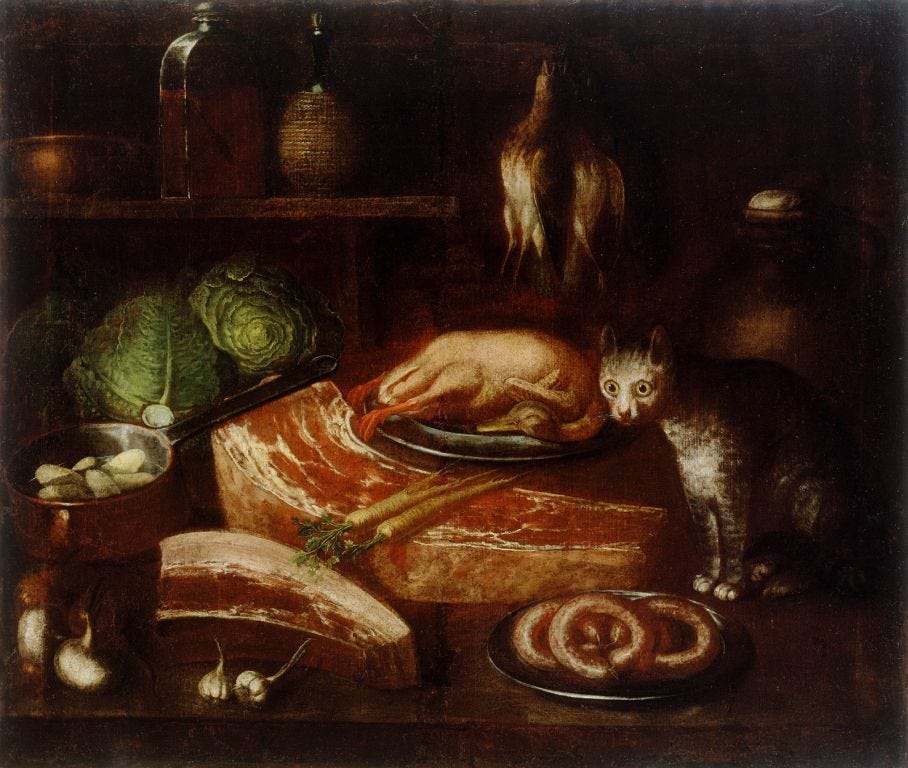
Was weird fiction invented in 1553? It’s tempting to consider. At the time, they certainly seem to have thought Beware the Cat was weird. The earliest response we have to Beware the Cat dates from 1570, and it’s a poem by an anonymous writer who attacks the book’s “staunge faschions” and its author, William Baldwin, for spreading lies. The poet maintains that “every thing almost in that boke is as tru / as that his nose to my dock [ass] is joyned fast with glu.” Which makes sense, since Beware the Cat is a novel about the adventures of a guy who uses alchemy to gain the ability to understand cats.
Anyway, happy late Halloween! It’s my absolute pleasure to discuss Beware the Cat. It’s been called the first-ever horror novel, but I personally feel that its other elements — humor, folktale, scientific discourse, mystery — keep it from being anything so classically definitive. It’s rarely frightening in the way that other horror literature (say, Macbeth) is, though it certainly gets eerie, and has some terrifying scenes. Its approach is frequently lighthearted — spoopy, rather than spooky — and Baldwin shifts tones suddenly when he feels called to it. The book’s elaborate descriptions of alchemical recipes, and its sustained interest in scientific concepts like vapors, optics, and “planeticall dominion,” mean that one can read Beware the Cat as a form of science fiction, in which 16th century ideas of how the world worked are used as the basis for fantastical events and situations. All in all, I think the weird label is worth extending to a work that meanders through the realms of horror, science fiction, and fantasy.
Beware the Cat was the brainchild of William Baldwin, a proofer, writer, eventual cleric, and significant figure in the mid-16th century printing and literary communities. Several of his works courted controversy, and Cat is no exception. Written in 1553, the book went unpublished for years due to its anti-Catholic elements and risk of reprisal under Mary I. It was eventually brought to print in 1570 (after Baldwin’s death), and again in 1584. Gray Area Press has a lovely paperback edition that includes the 1584 text, with its wild premodern grammar and spelling, as well as a more accessible version for modern readers, updated to include such technicalities as quotation marks and the the main character’s name being spelled the same way in each sentence.1 I’ll be quoting from the original 1584 text, since it’s more fun, and speaks to a period when grammar/spelling were still freewheeling, organic, and beholden more to aural speech than textual rules.
(Also, I highly recommend the Gray Area version as a holiday gift for horror/cat lovers — the price point is affordable, and the story actually takes place at Christmastide, during the dark depths of the year.)

Baldwin himself serves as narrator to the frame story, in which he and various other men are lodging with their host, Master of the Revels George Ferrers, for the Christmas festivities at Court. As the bedfellows settle down, they fall into debate on the question of “whether Birds and beasts ha[ve] reason.” One of them, a “divine” (churchman or theologian) with the delightful name of Master Gregory Streamer, contends that not only do animals possess reason, but that he’s heard them speak by means of his own “experimenting.”
From here, Baldwin takes on the role of transcriber, and Streamer himself becomes the narrator. In Part 1 of his Oration, Streamer relates various creepy stories of intelligent and supernatural cats told to him by others, and how a gathering of cats outside his lodgings seemed to have been speaking to each other. In Part 2, he describes his quest to find out what the cats are saying by means of alchemical recipes. He sets to work mashing together a series of concoctions/pâtés: the meat and organs of a hare, cat, hedgehog, and fox; the “grease” of all of the above; a “gelly” made of dung and wine, which he consumes. Through these mixtures, Streamer is granted enhanced auditory powers, and in Part 3, he’s able to eavesdrop on the cats, who hold a conclave to discuss their laws and some of the pranks they play on humans.
Part of the fun of Beware the Cat is how much Streamer is treated like a real person: the dedication (to the courtier John Young) refers to him as a mutual friend, and Baldwin assures that Streamer himself has approved the text on its way to print.2 In fact, I’m almost certain that the vituperative poem I mentioned at the beginning is actually just another part of the meta-meme: it attacks Baldwin for misrepresenting the fictional Streamer, a “good man” who would never tell “suche false fabels.”3 Within the book, Streamer rubs shoulders with real figures like Ferrers and the printer John Day, and scholars have observed that certain details of the lodging-house place Streamer in the “center of the Protestant printing industry of the Mid-Tudor period.”4 The sense of being brought into a tight-knit social scene, or a story improvised by friends about themselves, is what provides the novel much of its charm, even five hundred years later.
Like many early modern novels, Beware the Cat operates on multiple (even circular) levels of narration, with different nesting speakers all relating stories within the larger frame. (In the 1570 version, Streamer’s oration is further annotated with glosses by Baldwin in the margins.) Many of the stories end up connecting; the detective work of putting them together is one of the pleasures of Beware the Cat. I’ve tried to diagram a few below, just to convey the recursive structure of the narrative.
The gossipy nature of the different stories also works in well with the atmosphere of witchcraft: we receive news of the supernatural as it would have been spread in early modern Europe, through hearsay, wives’ tales, rumors heard second- or third- or fourthhand from a village far away. As a satirist, Baldwin draws comparisons between far-fetched “beleefs” in witchcraft and the credulity of Catholics (especially in Part 3). But he’s also up to to something more uncanny, using the scrambled narratives to build a sense of mystery and obfuscation, especially surrounding the true power of the cats and who their leader is. (More on this shortly.)
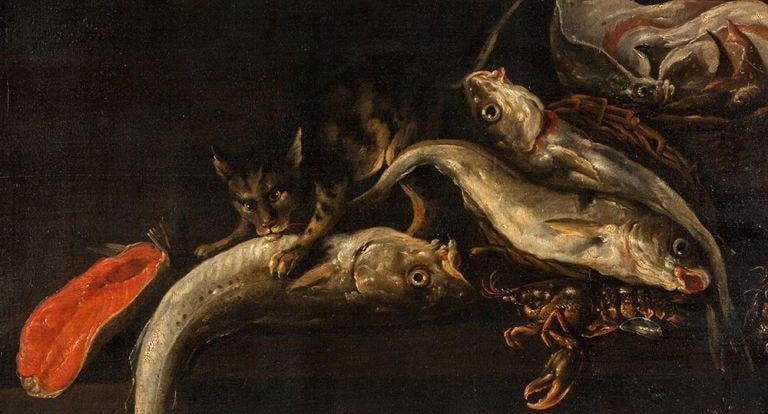
Overall, Baldwin exploits the fact that the boundary between “normal” Elizabethan life and the “perverse” nocturnal world of witches is often thin. Pollution and vapors abound in the background of the story; we’re living (literally) in Tudor meatspace, never far from a flayed carcass or a pile of entrails. Streamer’s discourse with the other boarders takes place in view of Aldersgate, where the “quarters of [hanged] men (which is a lothely and abhominable sight) doo stand upon Poles” as carrion pick at them. One of Streamer’s bedfellows, an Astronomer, makes candles out of horse’s brains; one of his acquaintances roasts cats alive for fun. Baldwin delights in scatological and physical humor (think priests getting shat on, cats biting dicks, Streamer eating cat turds, Streamer getting whipped on the ass).5 The larger setting of London becomes a Rabelaisian environment, full of nocturnal wildlife and hidden vices, as described by Streamer in one of the book’s tour de force passages:
Lord what [ado] do women ma[k]e in their beds? some scolding, some laughing, some weeping, some singing to their suckling children which made a woful noyse with their continuall crying… barking of dogges, grunting of hoggs, wauling of cats, rumbling of ratts…ringing of pannes, crowing of Cocks, sowing of socks, kacling of hens, scrabling of pennes, peeping of mice, trulling of dice…farting of churls, fisling [rustling] of girles, with many things else, as ringing of belles, counting of coines, mounting of groines, whispering of loovers, springling of ploovers, groning and spuing, baking and br[ew]ing, scratching and rubbing, watching and shrugging, with such a sorte of commixed noyses as would deaf any body to have heard…
The vast cacophony, with its mixture of human and animal noises, suggests both (1) the amusing similarities and close proximity between human and animal life, and (2) the eerie sense that animals are operating in private, hidden worlds under our noses. This culminates in the revelation that cats have their own secret language and society, and while Baldwin certainly gets in some jokes at their expense (e.g. it’s against cat law to refuse the “concupiscent company” of any other cat, not exceeding ten per night) the book is nevertheless full of eerie anecdotes which hint at some vaster feline power behind the scenes. Streamer learns of cats who, when one of their number is threatened by humans, will attack in a horde, and of cats who suddenly speak to humans — a word, a sentence — and then vanish. The power of cats seems to increase the farther one moves from human society: in the post-apocalyptic “wilderness” of Ireland, for example, soldiers encounter menacing cats, or cat-shaped demons, in the shadows of abandoned churches and burned-out villages.
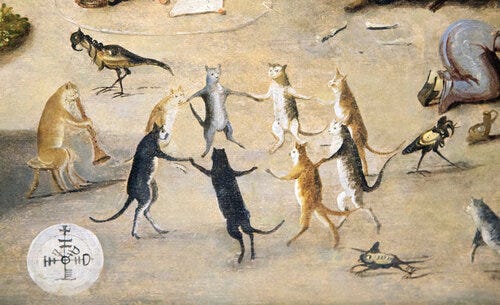

Throughout Beware the Cat, Baldwin also establishes what one could call a mythos: a series of entwined stories about the female arch-cat Grimalkin, who is worshipped by the other cats as a higher being or “Goddes.” Grimalkin is encountered 30 years before the events of the story as a menacing, speaking cat who approaches some Irish raiders and consumes the livestock they slaughter — a whole sheep, a whole cow. When they kill Grimalkin, retribution is terrible and swift. A swarm of cats kills the man who did it, and the surviving perpetrator has his throat bitten out by his own housecat. News of Grimalkin’s death spreads amongst the cats, and by the time Streamer eavesdrops on the conclave of cats in London, Grimalkin’s son Cammoloch has become the leader of catkind.
Grimalkin’s supernatural abilities are puzzling to the Streamer and the other humans, who theorize that she may be a human witch who took cat form and (like the Roman pope) fooled them into worshipping her; several decades later, her worship has become a kind of cargo cult. Though this explanation feels too easy — what do we make of her son, the ominous Cammoloch? Or the uncanny way that cats in England learn about her death so quickly? Not everything adds up, and we’re meant to wonder and speculate ourselves.

Freud speaks famously of the Uncanny as an ancient psychological inheritance, an instinct that dates from the “animistic stage in primitive men.” No matter how rational we become, we can’t help but imagine that objects, plants, and animals are watching us in the same way that we watch them. In fact, the more rational we become, and the more this animism is relegated to the Id, the more unnerving the experience becomes, the less able we are to articulate our dread. Among animals, cats seem especially to provoke to this kind of involuntary anxiety and projection: Montaigne, in the same century as Baldwin, wondered if his cat was indeed playing with him and not the other way around.
Beware the Cat can be read as a work of the uncanny, uniquely mapped onto the 16th century. Conceived during the first starts of the scientific revolution, it evokes (and is fond of) older themes of animism, the sense of being watched by other kinds. Take Baldwin’s final Exhortation, in which observes with equal parts humor and menace that a man will shoo a cat from his room when he intends to sin, “more a-shamed his cat should see [his secret wickedness] than God and his Angels.” This is a deeper and more haunting observation than Baldwin perhaps intended, and evokes a larger problem of religion. The Christianity of the 16th century reading class— codified, cross-referenced in printed books — certainly fed the rational mind, and provided men with huge volumes of information about metaphysical intelligences and the thoughts of an abstracted God. But what could Wittenberg, or Rheims, tell you about the cat? What doctrinaire authority could you consult if you woke up in the middle of the night, unnerved by yellow eyes observing you from across the room? Baldwin’s hypothetical Christian, as he shoos the cat out of his room, is processing God and the Angels distantly, in his superego. But the cat he processes in the less structured, animistic mind. It prompts irrational anxiety; he has to chase it from his room. In the end, it’s the Id bewares the cat, and rationality has little power to resist it.
On the subject of cats and the uncanny, Derrida says something which we should all keep in mind this Halloween:
Like all bottomless gazes, like the eyes of the other, this so-called “animal” gaze lets me see the abyssal limit of the human: the inhuman or anhuman, the ends of man, in other words the crossing of the limits at which man dares to introduce himself to himself.

Word-Hoard
Alkakengy (alkakengi): a species of nightshade, also known as "Chinese lantern" (“I took an ounce of alkakengy in powder which I had … bought at the Pothecaries”)
ambry: a cabinet or cupboard
bagagicall: a made-up word by Baldwin, generally meaning “shitty,” “ludicrous,” and “garbage”
beshems: pleas
cace: the skin (case) (“The Foxes whole body except the cace”)
celandine: a wildflower
crack-rope: one who ought to be hanged (“a shrewd boy, a very crack-rope”)
Diatessaron: a type of liturgical harmony
discommend: to disapprove (“[a play] whereof I discommended, saying it was not Comicall to make… speechless things to speak”)
draff: malt dregs
eggform: the shape of an egg. (“The roundness and eggform of the firmament.”)
exactions: demands for payment
forsaid: aforesaid
franion: a frivolous, loose person (“she & her franion had broke their fast with Capons”)
gargaristical: gargle-y (from gargarism)
greffier: a clerk
iukub: an incubus (“Demons, of which kind are Iukub and Succubus”)
kitling: a kitten (“a Kitling which his wife kept”)
lepry: leprosy (“miraculous as Naaman’s lepry”)
lovage: an herb
milt: spleen
misdoubt: to doubt
neap: high tide movement ("the neaping and spraying of the sea")
nuke memorative: possibly the spinal cord/spinal fluid (“I perceived that my brain cheefly the nuke memorative was mervelously well purged”)
obliquation: turning or bending aside
opillations: crowding, obstructions
pannicle: a membrane or tissue
pellicle: a filmy tissue ("the pelicle or filmy rime that lyeth within the bottom of mine ear hole")
peradventure: perhaps (“[The Pope] eateth and weareth as little as any other man, though paradventure more sumptuous and costly”)
portesse: a book of prayer or breviary
pottel: a half-gallon vessel (“a pottel of Wine which I put in the pot”)
presencial: referring to presence, clairvoyance, the divine (“called them Presenciall pilles, affirming that who so might eat one of them [should] prophesye”)
Pythoness: a priestess of Apollo
rades: a ray
sixsquare: hexagonal ("a Racket and a pair of sixsquare bowls")
surplice: vestment worn by priests
trosick/troche: a flat lozenge made of a dried substance
trumpery: stuff/possessions of limited use
unpurveyed: unforeseen
wawling: wailing, caterwauling (“what a wawling the cats had made there the night before from ten a clock til one”)
On some pages, Streamer is rendered “Streamer,” “Stremer,” and “Stemer.” Which is fun to read, since one wonders if there were multiple apprentices setting the type who switched off, or if they were short on letters/space and made do with fewer.
This is fun, because Baldwin himself was a proofer.
LEAVE STREAMER ALONE!!! Plus, the use of “bagagical” (which is pretty much unique to Beware the Cat) seems another part of the meme.
“I asked [the hunters] if they had seen any where any hedgehog that morning. And heer save that my tale is otherwise long, I would show you my mind of these wicked superstitious observations of foolish hunters, for they be like as seemeth to me the papists… [Since they think hedgehogs are bad luck] then are they unlucky Idolatrical miscreants Infidels and have no true beleefe in Gods providence I beshrew their superstitious hartes, for my buttocks bear the burthen of their misbeleef.”







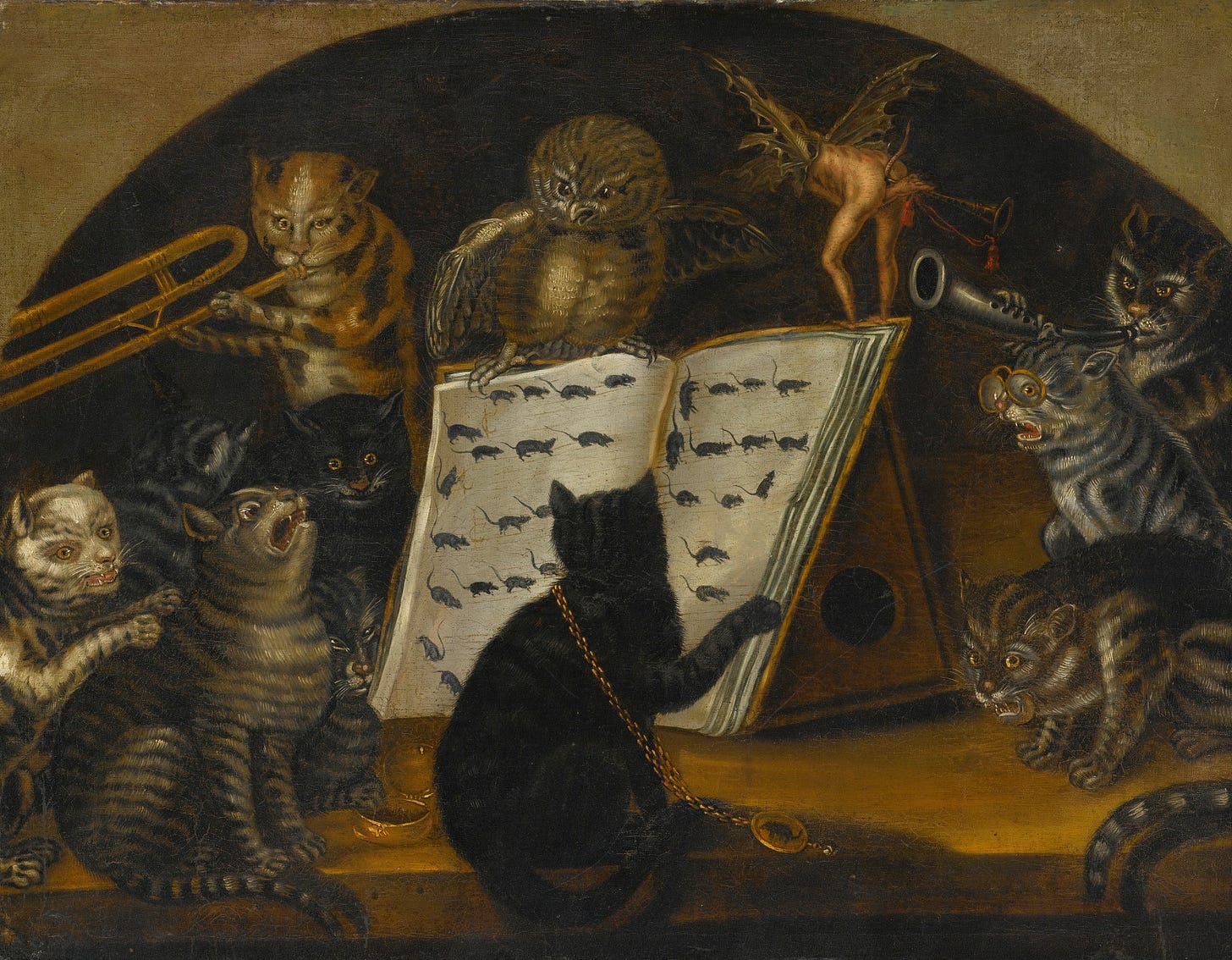
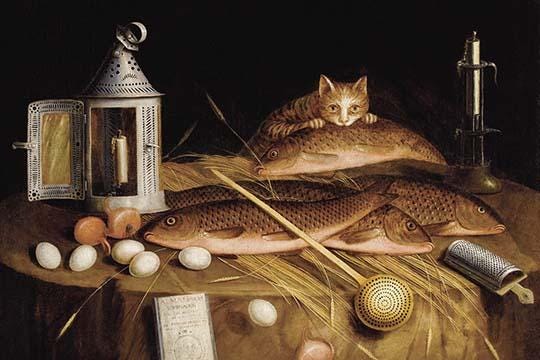
Damn. I think you've sold me on this one.
>> it’s against cat law to refuse the “concupiscent company” of any other cat, not exceeding ten per night
as a euphemism, it doesn't beat Melville's line about the way whales "salute" when "overflowing with mutual esteem."
EDIT: OH also my wife and I are seeing Branagh in Lear tomorrow. Are you catching it at some point?!?
Thinking about getting this book as a Christmas gift